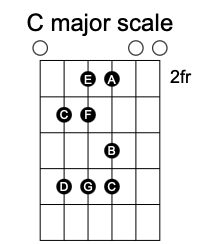The Major scale is a musical scale widely used in western music. In this article we learn about the major scale guitar.
The first thing to know is that the major scale is the basis for music development in the western culture for at least the last 500 years.
The major scale is equivalent to the seven standard music notes that we lean as children:
C, D, E, F, G, A, and B.
These notes are also the same as the white keys in a piano or keyboard.
They also appear as the notes that are represented without accident in a musical staff notation.
Major Scale in Other Keys
The description given in the previous paragraph works for the major scale starting in C. However, we can transpose the major scale to any tonality and have an equivalent major scale.
To be able to do this, we need to determine the intervals implied by the major scale. They are as follows:
- A whole step between C and D
- Again a whole step between D and E
- A half step between E and F
- A whole step between F and G
- Again a whole step between G and A
- Once more a whole step between A and B
- Finally the last step is a half step between B and A.
Using this information, we can transpose the major scale to any other tonality. For example, lets do this for the key of D:
- A whole step between D and E
- Again a whole step between E and F#
- A half step between F# and G
- A whole step between G and A
- Again a whole step between A and B
- Once more a whole step between B and C#
- Finally the last step is a half step between C# and D.
This indicates that the major scale for D includes the following notes:
D, E, F#, G, A, B, C#.
Chords on The Major Scale
The major scale is also important because it can be used to derive the most common chords. This is done by creating chords based on the notes of the scale.
For example, using the D major scale displayed above, we can create a few chords:
- D, F#, A: this is a major chord, since it has a major third.
- E, G, B: this is an E minor chord.
- F#, A, C#: a minor F# chord.
- G, B, D: a major chord
- A, C#, E: another major chord
- B, D, F#: a B minor chord
- C#, E, G: a diminished triad that can lead to D (dominant function).
With these chords, you can start playing several songs that are based on the major scale – there are a lot of them!
How to Play the Major Scale on a Guitar
You can easily play the major scale on a guitar. You just need to learn a pattern for the scale and use that shape for different keys as needed.
This is a very common shape that we’ll exemplify with the C major scale:

C-major scale
This simple shape is just one of the possibilities. But starting from there, you can play the major scale for other keys. For example, starting on the D of the 5th fret, instead of C in the 3rd fret, you can play the D-major scale. The same process will work for other keys down the neck.
Learning More About Guitars
If you want to learn more about scales on the guitar, I recommend our complete, free guitar course. In this course you’ll learn about:
- Finding any note in the guitar neck
- Playing basic chords
- Reading guitar tabs
- Playing guitar scales
- And much more
To get your free course, just click here and the PDF course will be sent to your email.
